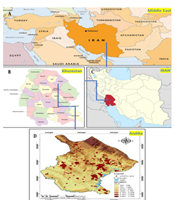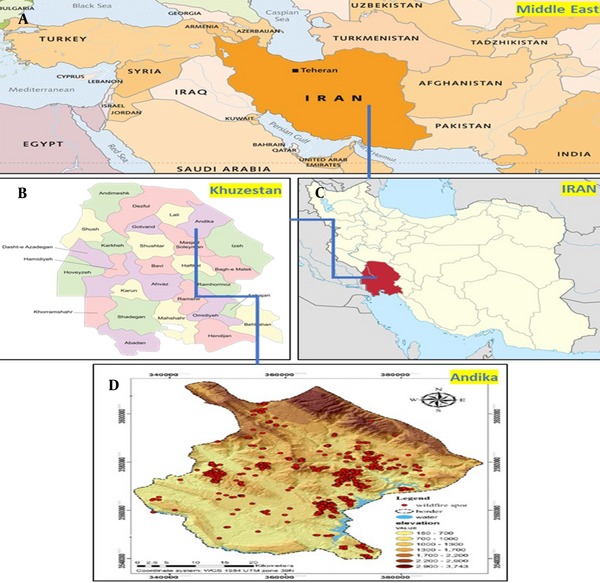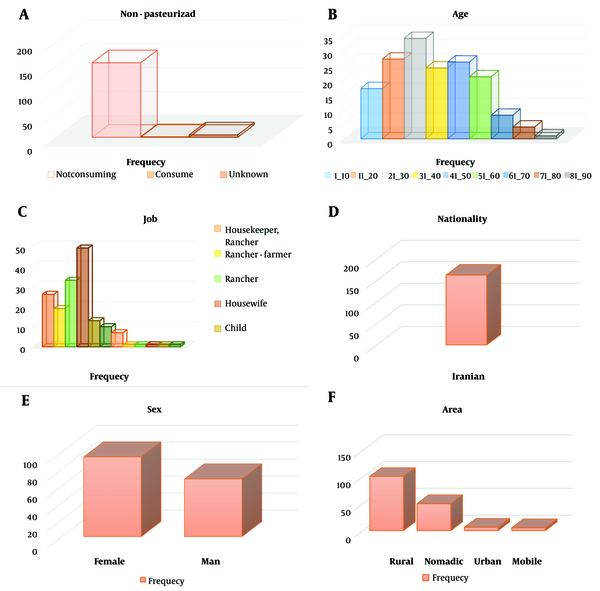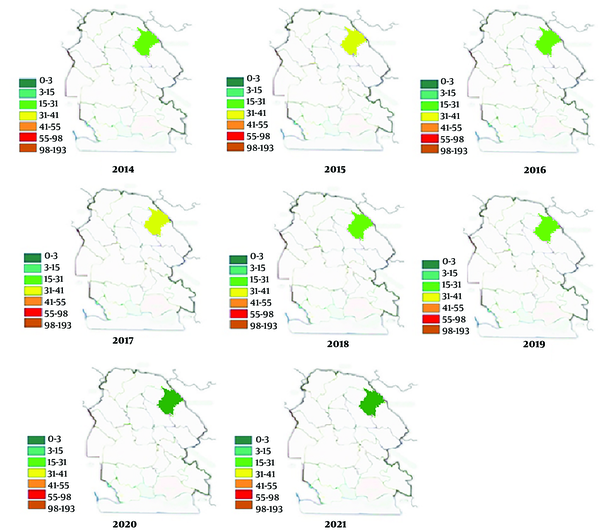1. Background
Brucellosis is a disease transmitted from animals to humans, with those affected referred to as having brucellosis (1-6). The spread of this disease is attributed to its prevalence in both domestic and wild animals (5, 7). In Iran, particularly in Khuzestan province, brucellosis has consistently been a significant health issue (4, 8, 9).
The bacterium responsible for brucellosis can be transmitted in three ways: Through inhalation, ingestion, and direct contact. Transmission routes include consuming unboiled milk, unpasteurized dairy products such as curd and cheese, and raw milk from infected animals. Additionally, the disease can be contracted when damaged or injured skin comes into contact with the blood or placenta of infected animals, especially if there are open wounds on the hands and gloves are not used (3, 10, 11).
The most prominent symptom of brucellosis is a fever ranging from 38 to 40°C, often accompanied by chills or a feeling of cold (12). Other symptoms include muscular and bone pain, headaches, severe night sweats, weakness and fatigue, loss of appetite, weight loss, depression, and enlargement of the liver and spleen (1, 13, 14).
According to reports from the WHO, approximately 500,000 people are infected with Maltese fever each year, and some researchers estimate that for every confirmed case of Brucella, there are 26 undiagnosed cases that go unreported (10, 15). Many countries in the eastern Mediterranean region are considered endemic areas for brucellosis. In Iran, despite having an excellent healthcare system, brucellosis remains a significant endemic disease, with Iran ranking fourth globally in terms of incidence (5, 8, 16).
Brucellosis is viewed through both economic and health lenses due to its impact on livestock, including fetal abortions, reduced milk production, sterility, and the consequent loss of economic value of affected animals, as well as its effects on human health. Despite improvements in food hygiene, this disease continues to pose health and economic challenges in many parts of the world, including the Middle East, Spain, Greece, Turkey, Mexico, India, and Peru (10, 17).
Infected livestock can abort fetuses during the early stages of pregnancy. During and shortly after abortion, these animals expel highly infected uterine secretions, contaminating the environment and pastures. This, in turn, leads to the contamination of other animals within the herd and poses a risk to humans (13, 18).
Andika is one of the newly established cities in Khuzestan province, located in the northeast of the region. In this city, the incidence of brucellosis has increased due to traditional animal husbandry practices, non-compliance with health conditions in the production of livestock products, direct contact between villagers and livestock, lack of regular vaccination, and failure to isolate and destroy diseased livestock (19, 20). Given the significance of brucellosis, which is one of the most critical diseases transmitted between humans and animals in both the world and Iran, special attention should be given to this issue from both economic and public health perspectives. The recent 30 percent increase in new infections underscores the urgency of addressing this situation. As health workers, it is our responsibility to focus on training and preventive measures to combat this disease.
2. Objectives
The purpose of this study was to investigate the epidemiology of brucellosis in Andika city from 2014 to 2021.
3. Methods
3.1. Study Design
This cross-sectional study was conducted in Andika city using information from the medical records of brucellosis patients registered with the Deputy Health Department, Non-communicable Diseases Unit, from 2014 to 2021. Data on the number of samples, types of health and treatment centers, various urban and rural areas, and other details such as age, sex, history of contact with infected animals, place of residence, occupation, consumption of dairy products (milk, cheese, and yogurt), and education were extracted from the patients' files. The diagnosis of brucellosis was based on clinical symptoms, radiographic findings, or pathology reports and recorded in the relevant tables.
3.2. Period of Study
The Study Lasted 84 Months, from January 2014 to December 2021.
3.3. Study of Area
Andika city is bordered to the northwest by Lali, to the north by Sardasht Dezful, to the north and northeast by Chaharmahal and Bakhtiari province, to the east by Izeh, and to the south by Masjed Suleiman. In 2006, when Andika was a district, its population was 49,728. The city encompasses 595 villages and settlements, six villages, and 33,000 hectares of agricultural land. The current population of Andika city is approximately 80,000, and it covers an area of 2,300 square kilometers. The city center is the small town of Qala Khajeh, which has a population of between 1,000 and 1,500 people (21). According to the 2016 census, the population of Andika city was 85,000. Figure 1 shows the location of the study.
3.4. Data Collection
This study focused on cases of brucellosis diagnosed in medical settings. The census method was used to collect data. This information was obtained from the registered files of patients at the Health Vice-Chancellor of Jundishapur University of Medical Sciences, Ahvaz - Non-communicable Diseases Unit.
3.5. Ethical Considerations
This research was conducted in accordance with ethical principles and standards for medical research. Ethical approval for the study was granted by the Ethics Committee of Ahvaz Jundishapur University of Medical Sciences, Ahvaz, Iran (IR.AJUMS.REC.1401.501).
3.6. Inclusion/Exclusion Criteria
The following inclusion criteria were considered in this study: (1) full text written in English; (2) articles focusing on *Brucella spp.* in livestock; (3) the criterion for diagnosing patients was culture and molecular testing; (4) studies focusing on animal brucellosis in Iran, including both total sample sizes and positive results. Documents lacking peer review, such as workshops, books, theses, and clinical trials, were excluded.
3.7. Statistical Analysis
The collected data were entered into Excel, and then the variables were coded. SPSS version 22 software was used for data analysis. To describe the variables, the mean and standard deviation were used for quantitative variables, while frequency and percentage of frequency were used for qualitative variables. This information was then statistically analyzed by a vital statistics expert. Due to the descriptive nature of the study, descriptive statistics such as the minimum rate, maximum rate, average, and relative frequency were used to present the study results.
4. Results
Table 1 shows the frequency distribution of brucellosis cases based on demographic characteristics, including age, gender, nationality, history of contact with infected livestock, history of consuming contaminated dairy products, and history of contact with other infected people in the family. According to Table 1, the proportion of women was 58%. The table also indicates that 160 cases had a history of contact with brucellosis, and 162 cases were of Iranian nationality.
| Variable and the Dependent | No. (%) |
|---|---|
| Age | |
| 1 - 10 | 17 (10.5) |
| 11 - 20 | 27 (16.7) |
| 21 - 30 | 24 (21) |
| 31 - 40 | 24 (14.8) |
| 41 - 50 | 26 (16) |
| 51 - 60 | 21 (13) |
| 61 - 70 | 8 (4.9) |
| 71 - 80 | 4 (2.5) |
| 81 - 90 | 1 (0.6) |
| Sex | |
| Female | 94 (58) |
| Man | 68 (42) |
| Nationality | |
| Iranian | 162 (100) |
| Non Iranian | 0 (0) |
| History of contact with infected animals | |
| Has it | 160 (98.8) |
| Does not have | 2 (1.2) |
| Region | |
| Rural | 101 (62.3) |
| Nomadic | 50 (30.9) |
| Urban | 6 (3.7) |
| Mobile | 5 (3.1) |
| Job | |
| Housekeeper, rancher | 26 (16) |
| Rancher, farmer | 19 (11.7) |
| Rancher | 33 (20.4) |
| Housewife | 49 (30.2) |
| Child | 13 (8) |
| Student | 10 (6.2) |
| Freelance job | 7 (4.3) |
| Other | 1 (0.6) |
| Manual worker | 1 (0.6) |
| The farmer | 1 (0.6) |
| Livestock worker | 1 (0.6) |
| Employee | 1 (0.6) |
| History of non-pasteurized dairy consumption | |
| Has it | 156 (96.3) |
| Does not have | 1 (0.6) |
| Unknown | 5 (3.1) |
| Infecting other family members | |
| Has it | 64 (39.5) |
| Does not have | 68 (42) |
| Unknown | 30 (18.5) |
Frequency Distribution of Brucellosis Cases Based on Demographic Characteristics in Andika City (2014 - 2021)
The map of Khuzestan province in Figure 2 shows the trend of frequency distribution of brucellosis cases based on demographic characteristics in Andika city over the last eight years. Figure 2A displays the prevalence of brucellosis related to the consumption of non-pasteurized dairy products. According to Figure 2A, most brucellosis cases are associated with unpasteurized raw milk or dairy products. Figure 2B illustrates the frequency of brucellosis by age. The highest incidence is observed in the 21 - 30 age group, while the lowest incidence is in the 81 - 90 age group. occupation Figure 2C depicts the frequency of brucellosis by job, with the highest incidence found among housekeepers due to contact with livestock, and the lowest among employees. Figure 2D shows the frequency of brucellosis by nationality, with a total of 162 cases. Figure 2E illustrates the frequency of brucellosis by gender, revealing an incidence of 58% in women and 42% in men. Finally, Figure 2F presents the frequency of brucellosis by region, with the highest incidence among residents of rural areas and the lowest among residents of mobile areas.
The map of Khuzestan province in Figure 3 shows the frequency of brucellosis cases in Andika city in the last 8 years.
5. Discussion
In the present study, the epidemiological situation of brucellosis in Andika city between 2014 and 2021 was investigated. According to the results, the highest frequency of brucellosis cases was reported in women (58%) compared to men (42%). This may be attributed to the cultural conditions of the region and greater contact of women with livestock or raw livestock products. These findings are inconsistent with those of Dehghan et al. (19), possibly due to differences in cultural conditions, food customs, geographical conditions, and economic status. Additionally, the results differ from those of Mostafavi and Asmand (5), which could also be due to variations in cultural conditions, food customs, geographical factors, and economic status.
In the study by Ebadi Fard Azar et al. in 2019, differences in the results may be due to weather conditions and the cold climate of the Diwandara region, which affects livestock management (22). Similarly, the study by Fouskis et al. in 2018 found different results, likely due to geographical conditions, food customs, cultural factors, and economic status (23). Furthermore, Nowrozinejad et al. reported different results due to exposure to infected livestock and consumption of non-pasteurized dairy products (24). The findings are also inconsistent with those of Enkelmann et al., potentially due to differences in employment, exposure to infected livestock, consumption of non-pasteurized dairy products, and lack of timely vaccination (25).
Moreover, the study by Nowrozinejad et al. showed differing results, possibly due to weather conditions and livestock management in the Diwandara region (26). In contrast, Akhvlediani et al.'s 2017 study showed similar results to this study (27).
Keyvanfar et al. studied the epidemiology, clinical and laboratory manifestations, and outcomes of brucellosis among 104 patients in referral hospitals in Tehran, Iran (28). Their study reported a mean patient age of 43.07 ± 18.52 years, with unpasteurized dairy consumption and contact with livestock reported in 60.6% and 27.9% of the patients, respectively (28).
Delam et al. investigated the epidemiology of brucellosis in southern Iran from 2015 to 2020 (29). The average annual incidence of the disease was 8.94 per 100,000 population. They reported that the Cochrane-Armitage trend test showed a significant reduction in the incidence of the disease from 2015 to 2020, which aligns with our study (29).
As stated in Akhvlediani et al.'s study, the consumption of non-pasteurized dairy products, including milk and uncooked food, as well as living in rural areas, has contributed to the increasing trend of this disease (27).
5.1. Study Limitations
The limitations of this study include the lack of accurate reporting of brucellosis cases by hospitals and healthcare centers, as well as their lack of follow-up.
5.2. Conclusions
This study investigated the incidence of brucellosis in Andika city. Brucellosis is one of the most contagious and common diseases transmitted between animals and humans. In this study, various factors such as gender, history of contact with infected livestock, occupation, region, consumption of unpasteurized dairy products, and contamination of other family members were examined. The results indicated that the disease is prevalent in rural communities, particularly among livestock workers and housekeepers. The higher prevalence in these groups is linked to their contact with infected animals and consumption of unpasteurized dairy products. Identifying these risk factors allows for the development of control measures, including thoroughly cooking meat, avoiding unpasteurized milk, using gloves when handling animals and their skin wounds, and ensuring the vaccination of animals.




